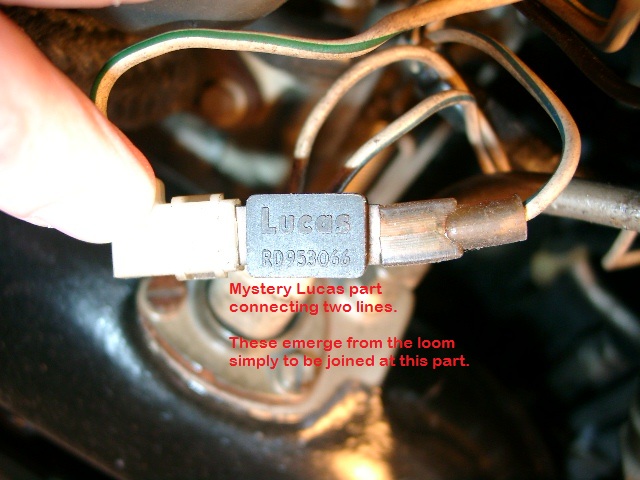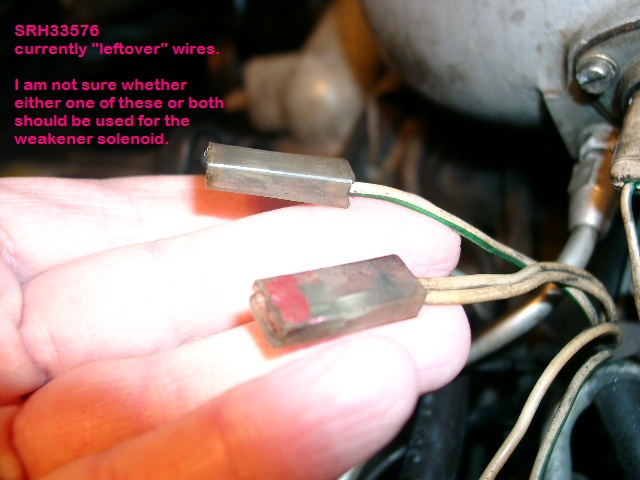| Author | Message | ||
Brian Vogel Prolific User Username: guyslp Post Number: 247 Registered: 6-2009 |
. . . the air intake temperature sensor switch (or I think that's what it is). I cannot find a good illustration with a description. The part number is UE39592 and Montague & Company describes it as an otter switch. It's mounted in the air intake pipe and has a triangular footprint on both of my cars. Any definitive answer as to what this thing is and what it does would be appreciated. Anyway, this question centers around the wiring for the two solenoids listed in the subject and that switch. My Silver Shadow II (SRH33576) is a European spec car that started out its life in the UK, made its way to the USA, and someone along the way converted it from RHD to LHD. My Silver Wraith II (LRK37110) is a U.S. spec car. Both cars have had some "mucking about" done on them but the SS far more than the SW. I think someone really screwed up the connections to the two solenoids on the SS, so today I set about trying to correct things, but there are always a couple of "extra" wires coming out of the loom in this area. I have used the SW as the pattern and would like some input from other owners of these cars as to how their wiring is laid out for these items. I will describe the various lines coming out of the loom and what they're connected. All terminate with a female slide connector and employ a double-male slide to mate with the female slide on the solenoids: ------------------------------------------ SW-II Anti-Dieseling/Anti-Run-On Double black wires > L lead Double white wires > R lead Weakener Single black wire > L lead Double white with blue tracer > R lead There is also a white wire with blue tracer joined to a white wire with green tracer using a small black box marked LUCAS RE953066 that "loops out and back in to the loom here. The switch mentioned at the start has a molded connector white wire to R terminal white w/green tracer to L terminal ---------------------------------------- SS-II: Anti-Dieseling/Anti-Run-On Double black wires > L lead Double white wires > R lead Weakener Single white wire > L lead Single white with green tracer > R lead The switch mentioned at the start has a molded connector black wire to R terminal white w/green tracer to L terminal Two "leftover" wires: a double white a single white with green tracer. ----------------------------------------------- If anyone happens to own similar models, would you mind having a look and letting me what your power source lines look like and what they're connected to? I was expecting something much more similar between these two cars, but alas. . . I also can't explain the presence of the "leftover" connections, either. Thanks in advance for any assistance you can offer. Brian, who would have used pictures, but the wire markings are just too hard to see | ||
Paul Yorke Grand Master Username: paul_yorke Post Number: 962 Registered: 6-2006 |
there are always a couple of spare wires . Otter switch in air intake turns off the engine if otters or other small animals are detected in the pipe. Sorry, otter is the manufacturer. the front the front valve is energized when the ignition is on and is the anti diesel valve . Normally closed until energized . the rear valve is the weakenr valve which is open at rest but closes and prevents the weakener operating until the otter switch detects air intake temp is warm enough.. black connector unit is a diode. That's from memory I'm afraid . | ||
Chris Browne Prolific User Username: chrisb Post Number: 102 Registered: 2-2010 |
Hello Brian, Regarding the "spare" wires you are concerned about. On my UK spec. Shadow 2, there are four spare wires, all with female connectors, which emerge from the loom close to the weakener and anti-diesel solenoids. I asked a Rolls-Royce technician about these when I first bought the car. He said that the engine bay looms which were fitted at the factory were suitable for various countries emissions requirements to save the hassle of fitting different looms for different locations I suppose. The left over wires are to connect various bits of emissions equipment which were not required for a UK based car. Hope this helps. Any chance you could post a photo or two of your wiring and switch queries? Kind regards, Chris | ||
Chris Browne Prolific User Username: chrisb Post Number: 103 Registered: 2-2010 |
Hello Brian again! A bit more information for you is that UE39592 is described in a factory bulletin as "Otter switch exhaust gas recirculation system" and it replaced part number UE37721. Your car was clearly made or adapted for a country where emissions regulations were in force at the time. There were no such regulations in the UK at that time. Kind regards, Chris | ||
Brian Vogel Prolific User Username: guyslp Post Number: 248 Registered: 6-2009 |
Chris, I will take photos and post simply because the "hard to see" stuff has been described. I am basing that part number on what I could find in the parts manual, which looks correct but is on a page where there are no descriptions for the parts. The description is from Montague & Company. The one thing I can say for sure is that whatever this thing is it's "standard issue" since it's on both cars and goes into an opening that's cast in the air trunk just prior to where it splits to go to each carb. It's not connected to the EGR (which I have on the SW-II but not on the SS-II) in any way that I can see. What I'd like to do on the SS-II is to be certain that the two solenoids are actually connected to the appropriate wires coming out of the loom. I'm absolutely certain at this point that this was not the case before and I still don't know whether the weakener solenoid is connected to the wires it should be. Brian | ||
Brian Vogel Prolific User Username: guyslp Post Number: 251 Registered: 6-2009 |
Chris, et. al., Here are photographs of the system in question from each of my cars:        Brian | ||
Paul Yorke Grand Master Username: paul_yorke Post Number: 963 Registered: 6-2006 |
There are always some spare wires wires which are normally just folded back and taped to the loom. Black Lucas connector unit is still a diode. You should have an ignition feed on the white wire to weakener solenoid. The white with blue trace goes to the air intake temperature switch (Made by Otter) which has a closed circuit to earth when cold (less than 14 degrees C ), then opens the circuit letting the valve close when it warms up. Get a test light on the weakener solenoid connections and make sure white side is live on ignition. Then Check across to the other wire which should light ( energising the valve) when cold then turn off when warm. Pull the connector off the switch to make sure it has it's earth etc. Bridge the contacts and the valve should click. Connect and disconnect a wire to the A/D Valve and it should click when the ignition is on. If the engine is running and warm, disconnecting the A/D valve wire should make the engine stall (immediately) | ||
Paul Yorke Grand Master Username: paul_yorke Post Number: 964 Registered: 6-2006 |
PS otter switches are also fitted in the thermostat housing, a 44 degree one for the air con fan cut out and a 105(ish) one for the auxiliary engine cooling fan. And one in the air con intake unit to turn off the compressor if ambient air is below zero. | ||
Brian Vogel Prolific User Username: guyslp Post Number: 252 Registered: 6-2009 |
Paul, Thank you very much for your responses. I've been doing "what's hot and what's not" testing to figure out what's what. Several years ago I had horrible problems with dieseling because, somehow, the anti-dieseling solenoid had been incorrectly connected to its source lines (and I believe I know by whom - not me). At that time I tested both solenoids and they were working fine, but it's worth checking again. The arrangement I came to for the anti-dieseling solenoid "worked," but was clearly not the correct one. It was some combination of the spare wires. I'd need to look at the color coding I put on the connectors at that time to see what that was, but since the car ran once started and promptly stopped when turned off I clearly had something that went hot on ignition. I also introduced a non-standard ground wire at that point, which is now out of the equation. I now suspect that the otter switch in the thermostat housing that determines whether the climate control comes on when in anything other than defrost mode may have died. I'll wait to make a final determination on that until I can get the car on the road again and really warmed up prior to turning the heat on. One thing I can tell anyone who wishes to test the anti-dieseling solenoid or weaker solenoid off the car is that you can really *feel* the activation when they're in your hand in addition to hearing the click. These two solenoids are "flip sides of the same coin." The anti-dieseling solenoid is: - open at rest [key not in run or start position] - closed when energized [key in start/run postions] while the weakener solenoid is: - closed at rest [intake air above 57°F/14°C] - open when energized [when bimetal switch makes contact when intake air is below 57°F/14°C]. Brian |